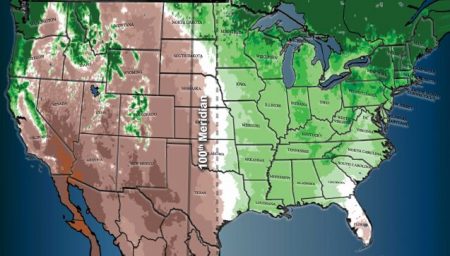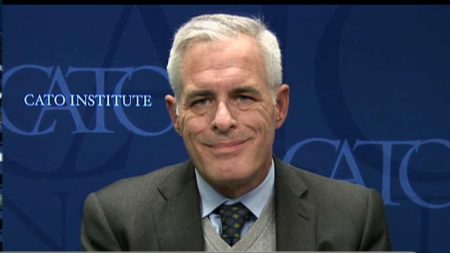April 16, 2018 – In today’s MIT Technology Review, author James Temple describes how a former climate change skeptic has a plan to get conservative politicians, fossil fuel companies, and other deniers of global warming to enact mitigation and adaptation policies. Temple describes the main reason there is resistance to act when he writes:
“We’ll never generate enough clean energy to dramatically cut emissions in the next few decades—while abandoning fossil-fuel plants that still work perfectly well—as long as so many political leaders adamantly deny even the existence of anthropogenic climate change.”
The reformed climate change skeptic is Jerry Taylor (see picture below) who formerly worked at the Cato Institute, and who appeared in conferences, and gave speeches that denied anthropogenic climate change. Since 2014 he has headed the Niskanen Center in Washington, DC where he is attempting to build a political coalition to enact a federal U.S. carbon tax. He along with a growing number of Republican and Democratic conservatives believe they can persuade others with similar political stripes to drink the Kool-Aid.
What are these strategies to make climate change a conservative issue?
- Pick the right political elites and send them clear messaging that is aimed at pulling “conservation” out of conservative. You may only need to change a few stubborn minds to get many others to move away from their anti-climate change action positions.
- Depoliticize climate change by addressing the skeptics arguments offering evidence that appeals to conservative ideologues. So don’t bring up regulating climate change through government action. Do talk about market-based tools, i.e., a carbon tax.
- Be selective about the policies you talk about and couch the language to conservative mindsets.
- Find common ground, policies that talk about innovation, energy independence, national security, and jobs.
So Taylor who espoused the climate denial propaganda that is now de rigueur Republican Party doctrine is now giving us the strategy which will help us undo the damage he and his like created. How kind.
One of the suddenly aware Republican groups in the U.S. is republicEn. The “En” stands for Encourage, a fall 2017 tour that brainstormed through the Republican Party heartland showcasing free-enterprise climate solutions and summoning lawmakers to create “Conservative Climate Courage.” RepublicEN, born out of George Mason University, describes itself as 4,382 Americans dedicated to educating the country about climate change and espousing solutions that don’t involve subsidies or regulations.
Taylor not only worked with the Cato Institute but also with the Heartland Institute, the latter a creation of the Koch brothers, and partially funded by ExxonMobil and other fossil fuel companies. The poisonous messaging these organizations have unleashed over the last decades has left Americans confused and skeptical about science facts. There is nothing of value that has come from their engagement with the American people.
And now Americans are finding out that climate change isn’t just about a few extreme weather events, and hotter days and nights. In a study authored by Richard Seagera, Lamont-Doherty Earth Observatory, Columbia University, Jamie Feldman, School of Engineering and Applied Sciences, Columbia University, Nathan Lis, Department of Meteorology and Atmospheric Science, The Pennsylvania State University, and Mingfang Ting, Alton P. Williams, Jennifer Nakamura, Haibo Liu, and Naomi Henderson of the Lamont-Doherty Earth Observatory, Columbia University, published April 11, 2018, it describes a major climate boundary shift in the continental United States, running north to south. A climate boundary first described by geographers some 140 years ago following the 100th meridian of longitude divided the dry west from a wetter east. Travelers back in the 19th century described the transformation in journal accounts as they traveled west from Missouri and Iowa into Kansas and Nebraska. Grasses and flowering plants common to the east side of the line vanished beyond the 100th meridian to be replaced by dry prairie grasses, yuccas, and succulents. That line today approximates the traditional end of the corn belt and beginning of a dry farming agricultural zone requiring extensive irrigation.
In 1900 the line was the 100th meridian. Now it is the 98th, a shift of approximately 225 kilometers or 140 miles easterly. And although yearly variation in precipitation and weather doesn’t always reflect the change, over time the data shows the dry side of the United States is marching relentlessly eastward. What this means for the agricultural heartland of America, also the Republican Party heartland, is a likely change in land use patterns with the consolidation of farms and the wider use of irrigation.
Other consequences of the shift is an overall drying of the Mississippi-Missouri Basin creating greater water uncertainty for cities that rely on this river network for water supply. And the United States may also see a decline in the navigability of the Mississippi-Missouri system, the largest river transportation network in the world.
The study’s observations, derived from accumulations of climate data, are consistent with climate models that show a general drying out of the continental United States as climate change further alters temperature and precipitation patterns.
One wonders as farmers in the midwest no longer can afford to stay on the land because of the impacts from the observed change in climate, will need to be convinced by the language of Taylor or by republicEn free-enterprise solutions.


















